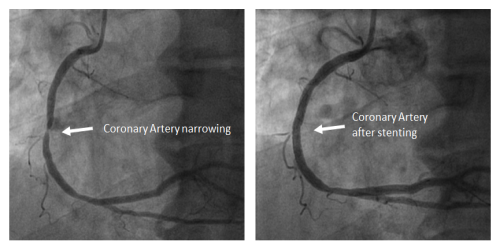
Coronary artery disease is the commonest heart condition resulting in hospital investigation and treatment in the UK. The symptoms are usually of chest pain or breathlessness and the condition may present as angina, heart attack (myocardial infarction), a hospital admission with chest pain at rest, or in association with another cardiac problem.
Many patients gain benefit from drug therapy, but when symptoms continue or when high-risk features are identified, patients often require coronary intervention to reopen the heart arteries at points where they are severely narrowed or blocked. This is done by passing a tube called a catheter through blood vessels to the heart. The entry point in to the circulation is via a puncture site in the wrist (radial access) or groin (femoral access). An angioplasty balloon is passed through this tube and enters the heart artery to re-expand it by inflating the balloon (coronary angioplasty).
In a high proportion of cases the procedure also involves insertion of a coronary stent. A stent is a metal meshwork tube that holds the vessel open once it has been inflated. The commonest types of stents now used are ‘drug-eluting’ stents. These are coated with chemicals that reduce the chance of any re-narrowing of the artery as the lining of the vessel grows over the stent and incorporates it in to the vessel wall.
